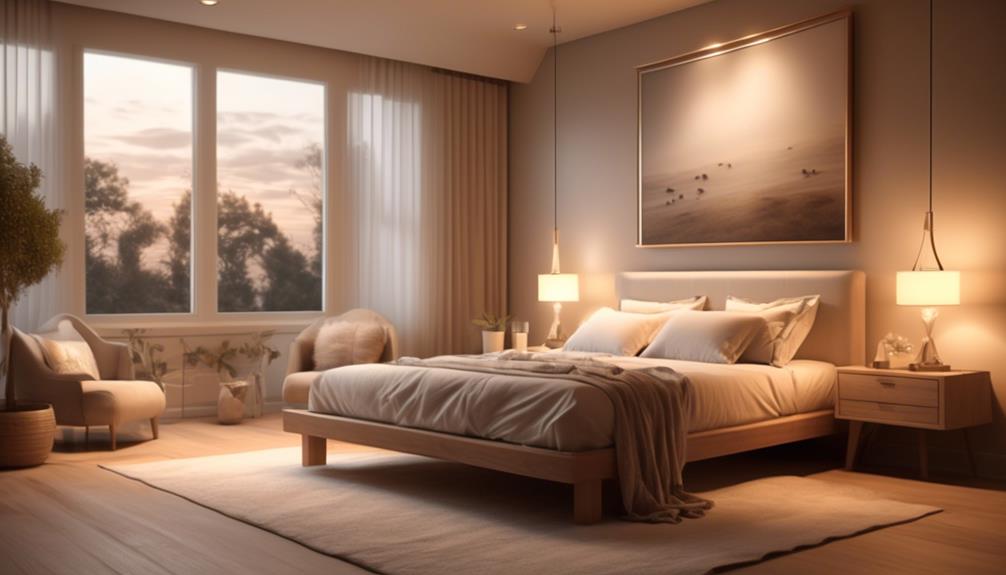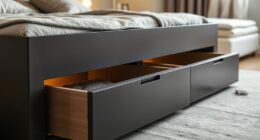The discussion on whether low beds are effective in preventing falls remains intricate and requires further examination.
As healthcare professionals, we are constantly seeking ways to enhance patient safety and well-being in clinical settings. The use of low beds as a preventive measure has garnered attention, but does it hold up under scrutiny?
Let's unpack this topic further and uncover the nuanced considerations surrounding the efficacy of low beds in mitigating fall risks.
Key Takeaways
- Low beds significantly contribute to fall prevention in healthcare settings.
- Enhanced visibility and monitoring capabilities help identify fall risks promptly.
- Adjustable frames and smart nightlights on low beds aid in preventing falls.
- Proper utilization of low beds, including fall mats and innovative solutions, prioritizes patient safety.
Research on Low Beds and Fall Prevention
Research indicates that the use of low beds in healthcare settings significantly contributes to the prevention of patient falls. In hospitals and nursing homes across the United States, the risk of falling is a significant concern, especially among elderly patients. Low beds play a crucial role in reducing this risk by providing a clear view of the surroundings, enabling better monitoring of patients. This unobstructed visibility helps healthcare staff to identify potential hazards promptly and respond to emergencies quickly. By lowering the height of the bed, low beds with adjustable frames further enhance fall prevention efforts. Additionally, features like smart nightlights can assist patients in navigating their surroundings safely, minimizing the chances of trips or falls.
Notably, faulty bed rails and improper bed height are culprits in many nursing home falls. The innovative Accora FloorBed, with its ultra-low height and profiling functions, offers a promising solution to prevent bed-related accidents. To address the root causes of falls in long-term care settings, implementing a restorative nursing program is essential. By prioritizing patient safety and utilizing low beds effectively, healthcare facilities can create a safer and more secure environment for both patients and staff.
Effectiveness of Low Beds in Healthcare

In healthcare settings, the effectiveness of low beds in enhancing patient safety and reducing fall risks is paramount. Low beds play a crucial role in patient care by providing clear visibility of the environment, enabling healthcare staff to monitor for potential fall risks and promptly intervene if needed. By reducing the height of the bed, low beds help in preventing falls and minimizing the risk of injury to patients.
Patients benefit from improved visibility of their surroundings, which can alleviate anxiety and enhance their sense of security. Additionally, the use of smart nightlights and adjustable bed frames further contributes to falls prevention efforts in healthcare settings. It's essential for nursing staff to ensure that bed rails are properly maintained and that bed height is adjusted correctly to mitigate the risk of patient falls.
Investing in innovative solutions like ultra-low height beds with advanced technology, such as the Accora FloorBed, can significantly enhance patient safety and prevent fall injuries in health care facilities.
Factors Influencing Fall Prevention Outcomes
Understanding the various factors that influence fall prevention outcomes is crucial in ensuring patient safety and well-being in healthcare settings. Hospital beds with lower heights or adjustable features play a significant role in preventing falls by providing better visibility for both patients and healthcare staff.
Enhanced visibility allows for quick identification of fall risks and prompt implementation of prevention strategies. Beds with transparent side panels or open designs further improve visibility, enabling a proactive approach to fall prevention.
In long-term care facilities, where adult inpatient injurious falls are a concern, the correct bed height, along with features like adjustable frames, scoop mattresses, and fall mats, are essential in reducing the risk of falls.
It's vital to recognize that faulty bed rails and improper bed height contribute significantly to the risk of falling, emphasizing the importance of utilizing low beds and appropriate prevention measures to enhance patient care and safety.
Case Studies on Low Bed Implementation

Implementing low beds in healthcare settings has shown promising results in enhancing patient safety and reducing the risk of falls. By opting for low-height beds, healthcare facilities can provide a safer environment for patients, thereby preventing fall-related incidents. Here are some case studies showcasing the successful implementation of low beds in different healthcare settings:
| Case Study | Results |
|---|---|
| Hospital A | Reduced fall rate by 20% within 3 months of low bed implementation. |
| Nursing Home B | Decreased fall-related injuries by 15% after transitioning to low beds with smart nightlights. |
| Rehabilitation Center C | Improved patient satisfaction and sense of security leading to a 25% decline in fall incidents. |
| Palliative Care Unit D | Enhanced caregiver monitoring capabilities resulting in a 30% reduction in fall rates. |
These case studies highlight the positive impact of low beds on patient care and fall prevention. By investing in low beds with features like adjustable frames and smart technology, healthcare facilities can prioritize patient safety and well-being effectively.
Recommendations for Utilizing Low Beds
How can healthcare facilities maximize the benefits of low beds to enhance patient safety and prevent falls effectively?
When utilizing low beds for fall prevention and patient safety, consider the following recommendations:
- Adjustable Bed Frames: Utilize low beds with adjustable frames to lower the bed height, reducing the risk of falls for patients with mobility issues.
- Smart Nightlights: Install smart nightlights on low beds to enhance visibility during nighttime, helping patients navigate their surroundings safely and prevent falls.
- Fall Mats: Place fall mats strategically next to low beds to cushion the impact in case of a fall, reducing the risk of severe injuries for patients.
Frequently Asked Questions
What Is the Optimal Bed Height for Preventing Falls?
For preventing falls, the optimal bed height is crucial. We consider factors like patient mobility, ease of getting in and out of bed, and risk of tripping. Our goal is to ensure safety and comfort for patients.
Why Keeping the Bed in Lowest Position Is Important?
When we prioritize keeping the bed in the lowest position, we create a haven of safety for those we care for.
This simple act not only empowers patients with independence but also offers them a clear view of their surroundings, reducing the risk of falls.
What Is the Lowest a Hospital Bed Will Go?
The lowest a hospital bed typically goes is around 4 inches from the ground. This height allows for better monitoring of patients and quicker responses to potential hazards.
Low beds also improve visibility for patients, reducing feelings of confinement and anxiety. Staff can easily assess the environment and make necessary adjustments to prevent falls, promoting a safer and more comfortable patient experience.
What Stops You From Falling Out of Bed?
We ensure patient safety by considering factors that prevent falls out of bed. Clear surroundings, removing obstacles, and adequate lighting are vital. Bedside rails and grab bars offer support. Regular mobility assessments help identify risks. Low adjustable beds reduce fall risks. Smart nightlights aid visibility.
Addressing faulty bed rails and incorrect heights is crucial. Innovative solutions like scoop mattresses and ultra-low beds with profiling functions are effective in preventing falls.
Conclusion
In conclusion, it's evident that low beds can play a crucial role in preventing falls in healthcare settings. By implementing environmental modifications such as low height beds, we can enhance patient safety and reduce the risk of injuries.
As the saying goes, 'an ounce of prevention is worth a pound of cure.' It's essential for healthcare providers to prioritize the use of low beds and adhere to recommendations to ensure optimal fall prevention outcomes.









